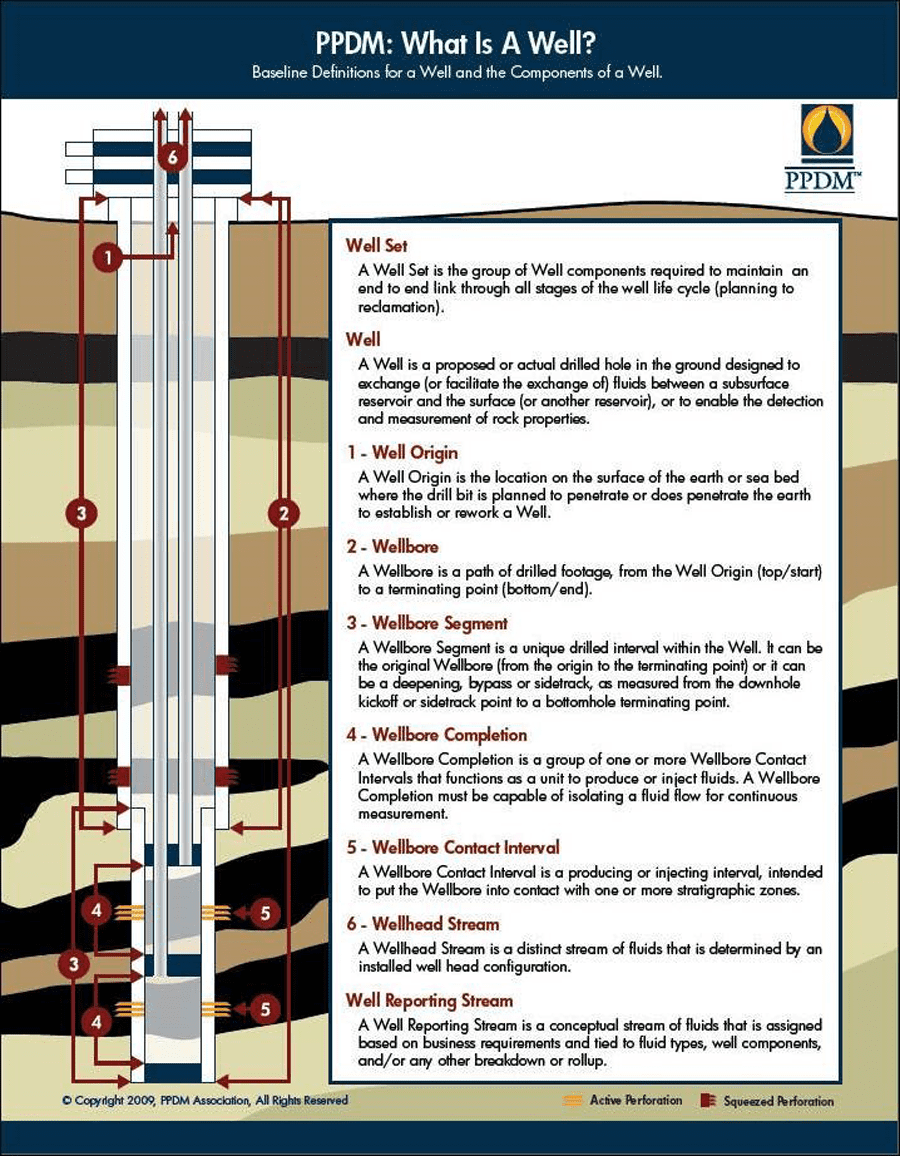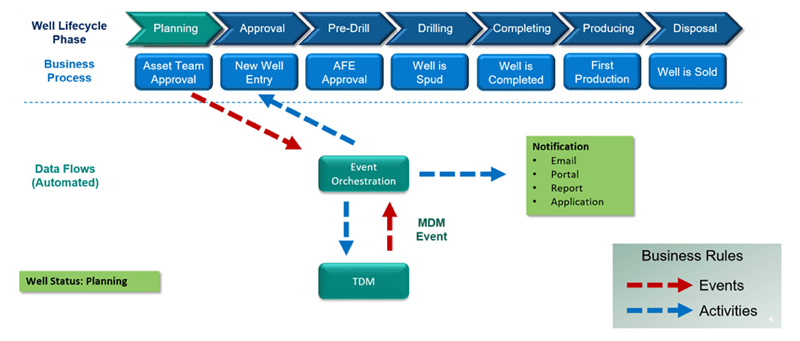It’s an exciting time in energy. Macro changes are transforming the industry and accelerating the adoption of technology at lightning speed. While the macro environment is shifting, the aspects of a good business strategy remain constant. The importance of quality data is becoming clearer, but an underinvestment in your data strategy negatively impacts a myriad of areas, from production and geological and geophysical (G&G), to legal and finance, and ultimately your critical business decisions. The proper foundation with an energy data platform can provide a competitive advantage and streamline your execution.
What is the Energy Data Platform?
The energy data platform is a single source of the most trusted data available to drive reporting, analysis, decisions and workflows across all aspects of the business, from exploration to engineering and operations. There are typically multiple domains covered in the energy data platform, including sub-surface, facilities, operations, finance, customer and, an area gaining a great deal of attention, ESG.
This does not mean that all the data is managed within a single repository. However, when we consider the Four Vs of data management: volume, velocity, variety and veracity, it is clear that trying to manage this in a consolidated store is impractical regardless of company size. Nor is the energy data platform a simple data warehouse or data lake where select data coalesces for specific business purposes.
An energy data platform integrates master data from across the organization based upon business rules, workflows, industry standards and best practices. It then delivers a consistent interface to access various data types and sources required by the business for business applications, reporting and analytics tools, and storage systems.
Why Has This Been a Problem for the Industry (and What is Different This Time)?
Historically, oil and gas companies operated as a series of distinct business units that defined and managed data according to contained, isolated workflows irrespective of the broader organization. When integration between the business units became a more pressing requirement, it was difficult to break down the barriers created by inconsistent governance, identification and format between these different functional groups. Standards initiatives, such as PPDM, attempted to resolve the issue by establishing global standards for a well and the subsurface components of a well. However, the challenge was that it would be costly and time-consuming for legacy application providers to implement these standards retroactively, and thus there was little progress.

PPDM’s “What is a Well?”
Fast forward, and more recently we’re seeing significant changes in creating and adopting an energy data platform. Attitudes are changing at the executive level, where many companies consider access to a single source of the truth as a key corporate goal. At the same time, incredible advances in cloud-based technology have minimized previous challenges associated with the Four Vs of data management.
What are the Key Components of the Energy Data Platform?
Governance
Effective data governance is a critical part of any digital transformation strategy. Unfortunately, many companies get paralyzed by data governance, spending years and millions of dollars developing too complex systems.
The reality is that most companies are trying to solve the same problems, and there is a wealth of governance information available to oil and gas companies through standards organizations such as PPDM and Energistics.
Master Data
Master data is the set of attributes that establishes the status of the business at any point in time and the relationships between the key business entities.
“Master data is the foundation for the digital transformation,” Gartner.
There are different domains for master data including well, facilities, operations, finance, customer and land. For example, if we consider the well domain, it is our experience that operators typically start with around 30 key attributes and, of these, about 80 percent are consistent between companies. However, at any point across the well lifecycle, there may be different Systems of Records (SORs) for each attribute. So, the MDM solution must accommodate this to maintain the golden record at any point in time.
These attributes can inform the company on the status of a well along its lifecycle and drive workflow automation, as discussed in the next section.
Workflow Automation
One of the key benefits of the energy data platform is connecting different business areas through common data, workflows and technology.
By synchronizing master data across different business units, we can recognize when changes occur and execute business rules that respond to these events by initiating a series of activities (see figure below).

Workflow Automation
Workflow automation is nirvana for operators. It increases efficiency by reducing downtime, minimizing errors and rework, enabling accurate and consistent reporting, and breaking down organizational silos.
What are the Trends of the Future?
Standardized Data Storage and Access
The OSDU initiative, spearheaded by Shell and other majors, gathered a significant amount of momentum in a very short period with over 150 members with 40 operators.
The goal is to establish a standardized format for storing data in the Cloud and the APIs for data ingestion and consumption. The major cloud providers, including Microsoft, AWS, Google and IBM, and other major technology providers like Dell, have signed up to deliver the platform as a service.
This approach is significantly different from prior standards initiatives in one respect: The ingestion and consumption of APIs. There are challenges ahead for the OSDU associated with corralling a community with day jobs to develop, maintain and support complex software through an open source-like structure. Regardless, the support for the initiative across the industry is a clear message of where things are heading.
Collaboration
Operators are overwhelmed by the pace of technology change and are increasingly turning to partnerships with vendors to help them navigate the transition.
“Things are changing so fast that we can’t keep up. We can no longer do it all ourselves, and [we] rely on collaboration with and between vendors.” Lee Holder, VP Upstream Digital Transformation, Shell.
Beyond the OSDU, we are also seeing alliances between vendors to deliver integrated industry solutions and are witnessing more collaboration between operators in areas where they believe that the benefits of working together outweigh any potential competitive advantage.
Data management is where the industry feels it is better to work together, which is a significant change from the past, and the industry will benefit.
Cloud Migration
It is evident throughout the industry that SaaS-based models for software deployment are replacing on-premises applications at a rapid rate. What is exciting, and potentially more challenging, is migrating vast volumes of data to the Cloud with the associated latency and cost issues. However, support for OSDU by leading cloud providers makes it clear they consider this a huge market and justifies significant investment on their part.
Application Innovation
Access to a centralized data store in the Cloud is driving innovation in the application space. Standardized API access to the most trusted data removes a significant barrier to continuous, rapid development. Rather than focusing a large part of development on loading and managing a copy of the data, developers can focus on innovative tools to visualize and analyze data that will deliver competitive advantages to customers.
This will have a significant impact on software vendors and be a long-term benefit to the industry.
Keys to Success
Establishing an energy data platform is crucial to the success of digital transformation initiatives. The keys to success are adopting a phased approach, focusing on the most critical areas first, and leveraging the vast amount of knowledge in the public domain.
Taking a look at EnergyIQ by Quorum Software is also a good start. It solves the challenging problems many won’t even know are a problem and has over 100 years of energy-specific knowledge captured within it.
Steve Cooper is Vice President of EnergyIQ by Quorum Software, a recognized leader in the oil & gas data management arena. As part of EnergyIQ, he has developed a sophisticated Well Master Data Management platform that supports critical decision-making at many oil and gas companies today. He started EnergyIQ in early 2008 after 14 years at Petroleum Information (later IHS) with 5 years spent as the CIO. He is a past Chief Communications Officer and Board Member with the PPDM Association. Additionally, he has served on the Board of Directors for two publicly-traded gold mining companies.
Steve holds a Ph.D. in Automated Mine Surveying & Planning, Nottingham University, England and Bachelor’s Degree in Mining Engineering from Nottingham University, England. He worked in several soft and hard rock mines upon graduating, but switched to the petroleum industry shortly thereafter, taking a number of classes at the Colorado School of Mines.
Steve has been published in numerous journals and has presented at industry conferences on subjects including data quality, governance, master data management, analytics and visualization. Recently, Steve joined the Data Analytics advisory board at Denver University and is an occasional contributor at the Colorado School of Mines.
Oil and gas operations are commonly found in remote locations far from company headquarters. Now, it's possible to monitor pump operations, collate and analyze seismic data, and track employees around the world from almost anywhere. Whether employees are in the office or in the field, the internet and related applications enable a greater multidirectional flow of information – and control – than ever before.





